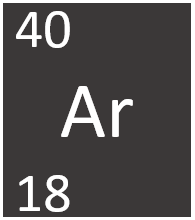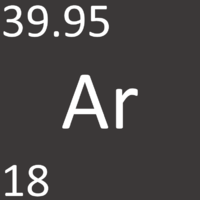Difference between revisions of "Argon"
(Created page with "==Key Stage 2== ===Meaning=== Argon is a gas. ==Key Stage 3== ===Meaning=== right|300px|thumb|The [[Chemical Symbol|chemical symbol for Argo...") |
|||
| (14 intermediate revisions by 2 users not shown) | |||
| Line 3: | Line 3: | ||
[[Argon]] is a [[gas]]. | [[Argon]] is a [[gas]]. | ||
==Key Stage 3== | ==Key Stage 3== | ||
| + | [[File:ArgonSymbol1.png|right|300px|thumb|The [[Chemical Symbol|chemical symbol]] for [[Argon]].]] | ||
| + | [[File:Ar-40_WK.PNG|right|200px|thumb|A 2 dimensional representation of a [[Argon]] [[atom]] with 18 [[proton]]s and 22 [[neutron]]s in the [[Atomic Nucleus|nucleus]] and 18 [[electron]]s orbiting the [[Atomic Nucleus|nucleus]].]] | ||
===Meaning=== | ===Meaning=== | ||
| − | + | ||
| − | [[Argon]] is a [[Group 0]] [[element]] an [[Atomic Number|atomic number]] of 18. | + | [[Argon]] is a [[Group 0]] [[element]], on the [[Periodic Table]], with an [[Atomic Number|atomic number]] of 18. |
===About Argon=== | ===About Argon=== | ||
| − | : [[Argon]] has the [[Chemical Formula|chemical formula]] [[Argon| | + | : [[Argon]] has the [[Chemical Formula|chemical formula]] [[Argon|Ar]]. |
: [[Argon]] has 18 [[proton]]s and 22 [[neutron]]s in its [[Atomic Nucleus|nucleus]] giving it an [[Atomic Number]] of 18 and an [[Relative Atomic Mass|atomic mass]] of 40. | : [[Argon]] has 18 [[proton]]s and 22 [[neutron]]s in its [[Atomic Nucleus|nucleus]] giving it an [[Atomic Number]] of 18 and an [[Relative Atomic Mass|atomic mass]] of 40. | ||
: [[Argon]] is a [[Noble Gas]]. | : [[Argon]] is a [[Noble Gas]]. | ||
: [[Argon]] is a [[gas]] at [[STP|room temperature]]. | : [[Argon]] is a [[gas]] at [[STP|room temperature]]. | ||
: An [[atom]] of [[Argon]] has a full [[Outer Shell|outer shell]] of 8 [[electron]]s so it is [[inert]]. | : An [[atom]] of [[Argon]] has a full [[Outer Shell|outer shell]] of 8 [[electron]]s so it is [[inert]]. | ||
| + | |||
==Key Stage 4== | ==Key Stage 4== | ||
| + | [[File:ArKS4.PNG|right|200px|thumb|The [[Chemical Symbol|chemical symbol]] for [[Argon]].]] | ||
| + | [[File:Ar-40_WK.PNG|right|200px|thumb|A 2 dimensional representation of the [[Bohr Model]] of a [[Argon]]-40 [[isotope]] with 18 [[proton]]s and 22 [[neutron]]s in the [[Atomic Nucleus|nucleus]] and 2 [[electron]]s in the first [[Electron Orbital|shell]], 8 in the second and 8 in the [[Outer Shell|outer shell]].]] | ||
===Meaning=== | ===Meaning=== | ||
| − | [[Argon]] is a [[Group 0]] [[element]] with 18 [[proton]]s in the [[Atomic Nucleus|nucleus]]. | + | [[Argon]] is a [[Group 0]] [[element]], on the [[Periodic Table]], with 18 [[proton]]s in the [[Atomic Nucleus|nucleus]]. |
===About Argon=== | ===About Argon=== | ||
| − | : [[Argon]] has the [[Chemical Formula|chemical formula]] [[Argon| | + | : [[Argon]] has the [[Chemical Formula|chemical formula]] [[Argon|Ar]]. |
: The most [[Stable Isotope|stable isotope]] of [[Argon]] has 22 [[neutron]]s in its [[Atomic Nucleus|nucleus]] giving it an [[Relative Atomic Mass|atomic mass]] of 40. | : The most [[Stable Isotope|stable isotope]] of [[Argon]] has 22 [[neutron]]s in its [[Atomic Nucleus|nucleus]] giving it an [[Relative Atomic Mass|atomic mass]] of 40. | ||
: [[Argon]] is a [[Noble Gas]]. | : [[Argon]] is a [[Noble Gas]]. | ||
| Line 22: | Line 27: | ||
: An [[atom]] of [[Argon]] has a full [[Outer Shell|outer shell]] of 8 [[electron]]s so it is [[inert]]. | : An [[atom]] of [[Argon]] has a full [[Outer Shell|outer shell]] of 8 [[electron]]s so it is [[inert]]. | ||
| − | + | ===References=== | |
| − | + | ====AQA==== | |
| − | + | :[https://www.amazon.co.uk/gp/product/0008158770/ref=as_li_tl?ie=UTF8&camp=1634&creative=6738&creativeASIN=0008158770&linkCode=as2&tag=nrjc-21&linkId=ec31595e720e1529e49876c3866fff6e ''Argon, page 59, GCSE Physics; Student Book, Collins, AQA'] | |
| − | + | :[https://www.amazon.co.uk/gp/product/0008158762/ref=as_li_tl?ie=UTF8&camp=1634&creative=6738&creativeASIN=0008158762&linkCode=as2&tag=nrjc-21&linkId=a0fffa35b3ea49a63404f6704e0df7cc ''Argon, pages 40-1, 58, 294-5, GCSE Chemistry; Student Book, Collins, AQA'] | |
| − | + | ||
| − | + | ====OCR==== | |
| + | |||
| + | :[https://www.amazon.co.uk/gp/product/1782945695/ref=as_li_tl?ie=UTF8&camp=1634&creative=6738&creativeASIN=1782945695&linkCode=as2&tag=nrjc-21&linkId=ceafcc80bcad6b6754ee97a0c7ceea53 ''Ar, page 104, Gateway GCSE Combined Science; The Revision Guide, CGP, OCR ''] | ||
| + | :[https://www.amazon.co.uk/gp/product/1782945679/ref=as_li_tl?ie=UTF8&camp=1634&creative=6738&creativeASIN=1782945679&linkCode=as2&tag=nrjc-21&linkId=a2db42f7b4bdf10cafaafa3bb9120940 ''Ar, pages 15, 16, 31, 38, GCSE Chemistry; The Revision Guide, CGP, OCR Gateway ''] | ||
Latest revision as of 14:02, 19 February 2021
Contents
Key Stage 2
Meaning
Key Stage 3
Meaning
Argon is a Group 0 element, on the Periodic Table, with an atomic number of 18.
About Argon
- Argon has the chemical formula Ar.
- Argon has 18 protons and 22 neutrons in its nucleus giving it an Atomic Number of 18 and an atomic mass of 40.
- Argon is a Noble Gas.
- Argon is a gas at room temperature.
- An atom of Argon has a full outer shell of 8 electrons so it is inert.
Key Stage 4

A 2 dimensional representation of the Bohr Model of a Argon-40 isotope with 18 protons and 22 neutrons in the nucleus and 2 electrons in the first shell, 8 in the second and 8 in the outer shell.
Meaning
Argon is a Group 0 element, on the Periodic Table, with 18 protons in the nucleus.
About Argon
- Argon has the chemical formula Ar.
- The most stable isotope of Argon has 22 neutrons in its nucleus giving it an atomic mass of 40.
- Argon is a Noble Gas.
- Argon is a gas at standard temperature and pressure.
- An atom of Argon has a full outer shell of 8 electrons so it is inert.
References
AQA
- Argon, page 59, GCSE Physics; Student Book, Collins, AQA'
- Argon, pages 40-1, 58, 294-5, GCSE Chemistry; Student Book, Collins, AQA'

